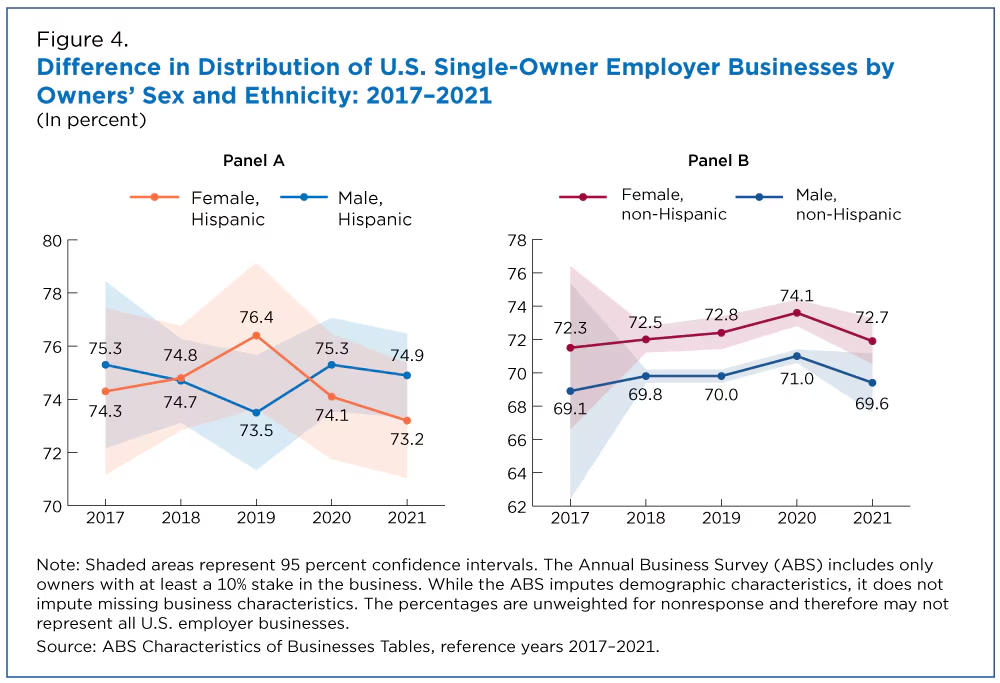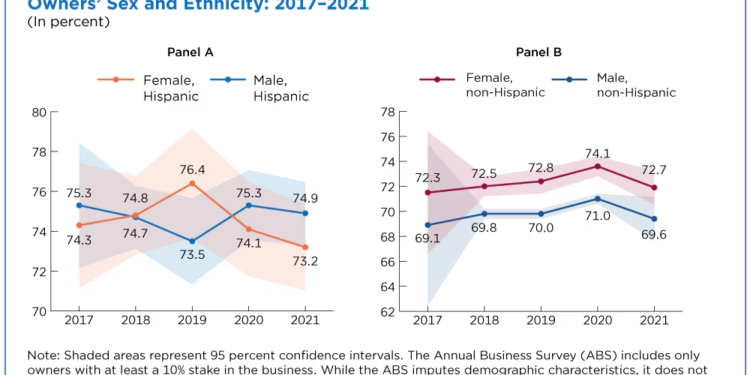More than half of the businesses in the United States had a sole owner, consistently outnumbering multi-owner businesses each year from 2017 to 2021, according to an analysis of the U.S. Census Bureau’s Annual Business Survey (ABS), which explores how reported business ownership varies by sex, race and ethnicity over time.
Between 2018 and 2021, women-owned businesses were consistently more likely than male-owned to have one owner.
During the five-year period, the share of businesses with a single owner was remarkably stable, averaging 59.2%. By comparison, businesses with two to four owners made up an average 36.3% of all respondent firms, (Figure 1).
The share of businesses owned by five to 10 owners and those with 11 or more owners was significantly smaller and showed little variation. The portion with five to 10 owners consistently remained under 2% on average, while businesses with 11 or more owners accounted for about 1% of firms during this period.

Distribution of Sole Ownership by Sex of Business Owners
Between 2018 and 2021, women-owned businesses were consistently more likely than male-owned to have one owner. (The difference in 2017 was not statistically significant.)
On average, 73.0% of women-owned businesses were solely owned, compared to 70.2% of male-owned businesses. This resulted in a persistent gap of 2.8 percentage points in sole ownership between men and women, (Figure 2).

Sole Ownership by Sex, Race, and Ethnicity
Women-owned businesses were more likely to be sole owners than male-owned businesses across race and ethnic categories between 2018 and 2021. (The difference was not statistically significant in 2017).
Among minority-owned businesses (defined as a business owned by a person or persons of any race or ethnicity other than non-Hispanic White), on average 75.8% of those owned by women and 73.1% of those owned by men had one owner — an average difference of 2.7 percentage points, (Figure 3, Panel A).
Similarly, non-Hispanic White women-owned businesses were more likely than male-owned ones to have a single owner. From 2018 to 2021, an average of 72.5% of non-Hispanic White women-owned businesses and 70.0% of non-Hispanic White male-owned businesses were sole ownerships, yielding an average difference of 2.5 percentage points, (Figure 3, Panel B).

Sole Ownership Among Hispanic and Non-Hispanic Owned Businesses by Sex
From 2017 and 2021, an average of 74.6% of businesses owned by Hispanic women had a single owner. There was no statistically significant difference in the share of sole ownerships between businesses owned by Hispanic women and Hispanic men during this period, (Figure 4, Panel A).
But differences between businesses owned by non-Hispanic women and men emerged after 2018.
From 2018 to 2021, non-Hispanic women-owned businesses were 3.0 percentage points more likely to have a sole owner than male-owned businesses: 73.0% and 70.1%, respectively, (Figure 4, Panel B).































Discussion about this post